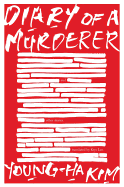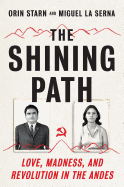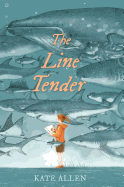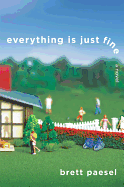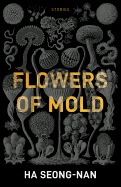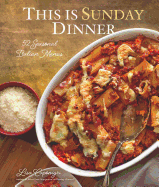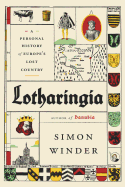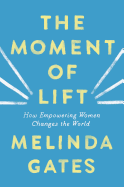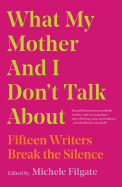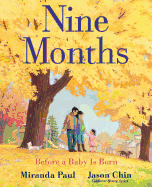Friday, May 3, 2019
 When I found out I was pregnant, I turned to books in search of answers to the roughly one million questions I had about what to expect. First up was Like a Mother: A Feminist Journey Through the Science and Culture of Pregnancy (Harper Wave, $24.95)--a book that's fast becoming my go-to "if you read just one book about pregnancy..." recommendation. Angela Garbes offers readers a candid exploration of pregnancy that is part memoir and part science, full of heartfelt stories and absolutely fascinating details about what the human body can do in preparation for a new little one. And Now We Have Everything (Back Bay, $16.99) was another candid (sometimes shockingly so) memoir of motherhood, speaking openly and honestly about tough subjects like 40-hour labor and postpartum depression. Some of these same topics--the ups and downs of the experience, and the many different forms it can take--feature heavily in the story collection Look How Happy I'm Making You (Doubleday, $24.95).
When I found out I was pregnant, I turned to books in search of answers to the roughly one million questions I had about what to expect. First up was Like a Mother: A Feminist Journey Through the Science and Culture of Pregnancy (Harper Wave, $24.95)--a book that's fast becoming my go-to "if you read just one book about pregnancy..." recommendation. Angela Garbes offers readers a candid exploration of pregnancy that is part memoir and part science, full of heartfelt stories and absolutely fascinating details about what the human body can do in preparation for a new little one. And Now We Have Everything (Back Bay, $16.99) was another candid (sometimes shockingly so) memoir of motherhood, speaking openly and honestly about tough subjects like 40-hour labor and postpartum depression. Some of these same topics--the ups and downs of the experience, and the many different forms it can take--feature heavily in the story collection Look How Happy I'm Making You (Doubleday, $24.95).
 And looking for some science to back up all the new rules I found myself subject to, I dove right into Expecting Better (Penguin Books, $17), in which Emily Oster uses her background as an economist to unpack the statistics behind many, many studies that surround the common "rules" of pregnancy. Oster has also written Crib Sheet (Penguin Press, $28), a book on parenting using the same stats-based technique.
And looking for some science to back up all the new rules I found myself subject to, I dove right into Expecting Better (Penguin Books, $17), in which Emily Oster uses her background as an economist to unpack the statistics behind many, many studies that surround the common "rules" of pregnancy. Oster has also written Crib Sheet (Penguin Press, $28), a book on parenting using the same stats-based technique.
 More recently, I picked up (and loved) What No One Tells You (Simon & Schuster, $17), a guide to the emotions of pregnancy. While many pregnancy books focus more on the physical aspect of growing a tiny human, there are a lot of feelings mixed up in the process, I've learned. --Kerry McHugh, blogger at Entomology of a Bookworm
More recently, I picked up (and loved) What No One Tells You (Simon & Schuster, $17), a guide to the emotions of pregnancy. While many pregnancy books focus more on the physical aspect of growing a tiny human, there are a lot of feelings mixed up in the process, I've learned. --Kerry McHugh, blogger at Entomology of a Bookworm
Diary of a Murderer
by Young-Ha Kim, transl. by Krys Lee
"The way you feel about writing poems that no one reads and committing murders that no one knows about is not that different," declares the protagonist of Diary of a Murderer's title story. His musings set the tone for this slim collection by celebrated Korean novelist Kim Young-ha (I Hear Your Voice; Your Republic Is Calling You). The first book of Kim's short fiction to be translated into English, Diary of a Murderer includes four stories, each a darkly funny meditation on grandiosity, deception and the perilous intersections between creativity and violence.
In the title story, an aging serial killer's peaceful life is upended after he is diagnosed with dementia, which erodes his psychological defense mechanisms as ruthlessly as it devours his memory. In "The Origin of Life," a young man fails to intervene in the abusive marriage of his childhood friend and nascent lover; and in "The Writer," a novelist seeks revenge on his ex-wife, whom he suspects is sleeping with her employer. The most poignant entry, "Missing Child," tells the story of a man who is reunited with his kidnapped son after an 11-year absence, forcing both to accept that what is lost can't always be recovered.
Kim's fiction is often nihilistic, but the naked vulnerability of his characters--even the most despicable ones--grounds and elevates it. Though these stories contain aspects of the horrific, the lurking specter they share is not the threat of annihilation, but the threat of self-knowledge. Confronted with the disparity between our ideal selves and the reality of what we must do to survive, none of us can expect to emerge unscathed. --Devon Ashby, sales & marketing assistant, Shelf Awareness for Readers
Discover: These transgressive short stories by Korean novelist Kim Young-ha explore the terrors of moral failure, regret and the irrevocability of the past.
Everything Is Just Fine
by Brett Paesel
It's the start of a new season for the Beverly Hills junior soccer league, and Coach Randy is pumped. He's sending e-mails to all the players' parents, with lots of exclamation points, inspirational quotes from Braveheart and tips on how the team can use "focused rage" on the field. The players are 10 years old.
One of the parents is newly divorced Diane, whose habit is to reply late at night with bluntness to the mass team e-mails and then apologize the next day for her rambling drunk messages. She may be harsh with her criticisms but she's not wrong. There's also Jacqui, the team mom, who remains unassailably positive, always reminding everyone "it DOESN'T MATTER who wins, it's playing the game that counts."
Brett Paesel's Everything Is Just Fine follows these characters and more, including Coach Randy's unhappy wife, the assistant coach and star kid player, as they navigate the season and the obstacles in their personal lives. Parts of their stories are extrapolated from e-mails, and what seems funny at first deepens into an exploration of how people in Beverly Hills mansions with fancy decks can be unhappy, too. They're contradictory--upbeat and depressed, brave and anxious, promiscuous and lonely--just like anyone. Most of these characters don't even like one another, but Paesel demonstrates that when it counts most, they can still rally to support and treat others with compassion. In the end, it really isn't about winning, but choosing to stay in the game of life. --Elyse Dinh-McCrillis, blogger at Pop Culture Nerd
Discover: The coach and parents involved in a junior soccer league help their kids excel on the field while making a mess of their own lives.
The Dream Peddler
by Martine Fournier Watson
With The Dream Peddler, Martine Fournier Watson delivers a quietly magical tale of a town reeling from tragedy. In the middle of a frantic search for a missing child, a mysterious traveling salesman, Robert Owens, arrives in town. After Benjamin Dawson is found frozen under the ice in the bay, Owens reveals that, for a small fee, he can mix up a potion that will give you whatever dream you want. Townspeople start seeking him out, looking for distraction, for hope, and--as in the case of Ben's mother--a comfort that can't be found anywhere else. But if the peddler's dreams inspire comfort and hope, they also give rise to darker emotions, and it's not long before the community begins to unravel.
As inspiration for her debut novel, Watson cites Emily Starr, heroine of a lesser-known and subtly darker series by Anne of Green Gables author L.M. Montgomery. Montgomery wrote of a moment in which her heroine, overcome with grief and shame, destroys a manuscript titled "The Dream Peddler." Watson has now breathed life into that obscure literary ghost, creating a compelling story focused on the concepts of imagination, identity and accountability. Her characters are complex and well rounded, and her setting--an early 20th-century farming town--is an evocative mix of idyllic and repressed. With some lovely prose, intense imagery and deft handling of magical realism, The Dream Peddler is a strong debut from an impressive new artist. --Judie Evans, librarian
Discover: This debut is a haunting and evocative story of strength and weakness in the face of devastating loss.
Flowers of Mold & Other Stories
by Ha Seong-nan, transl. by Janet Hong
Exploring themes of alienation and control, Ha Seong-nan's Flowers of Mold & Other Stories (translated from Korean by Janet Hong) uses elements of absurdity to introduce people dealing with an alienating urban society and a suffocating traditional culture.
"When did the button of my life go in the wrong hole?" asks a letter-writer in "Toothpaste." Dissatisfaction afflicts many characters, but they're unable to change course. Metaphors for escape appear throughout. In "Waxen Wings" a young female gymnast, bullied and exhausted from training, says, "...if people could escape the confines of gravity, they could fly like birds." A wife and mother in "The Woman Next Door," possibly losing her mind from boredom, remarks that her husband says she's "always floating around in space, never touching solid ground."
People are isolated, for the most part, living in large cities. In the title story, a man surreptitiously goes through garbage bins in his apartment complex, getting to know his neighbors in the only way he can imagine. Yet traditional Korean expectations remain. Women often experience unchecked harassment. They may have careers, but are expected to be "prim and composed," and leave work when (not if) they marry. Men are restrained, too, and any aberration, personal or professional, requires apologies and shame.
Ha's ability to find startling traits in seemingly unremarkable characters makes each story a small treasure. This collection is a welcome contribution from an accomplished author, joining the company of Han Kang and Bae Suah in newly translated Korean literature. --Cindy Pauldine, bookseller, the river's end bookstore, Oswego, N.Y.
Discover: Flowers of Mold & Other Stories offers unsettling tales of people fighting against isolation and despair from a master of Korean literature.
Science Fiction & Fantasy
Waste Tide
by Chen Qiufan, transl. by Ken Liu
In a provocative science fiction debut translated by Locus winner Ken Liu (The Grace of Kings), Chen Qiufan conceptualizes a near future shadowed by the drawbacks of tech consumerism.
A few years from now, electronic body modifications are commonplace and virtual reality is the drug of choice, but life on Silicon Isle mirrors the conditions of any historical high-demand, low-regulation industrial boom. Tightly controlled and barely paid by the three wealthy clans who employ them, workers termed "waste people" put in long hours processing the world's recyclable electronics, from cellular phones to bionic limbs. The arrival of American businessman Scott Brandle with a profitable automation proposal causes dissent among the ruling clans, while Brandle's translator Kaizong suspects his employer is more than he seems. A young scion of the Chen clan, Kaizong has returned from an education abroad to reconnect with his home. When he rescues Mimi, a waifish waste girl, from the abuses of rival clan thugs, their budding romance opens his eyes to the plight of the workers. Neither imagines that Mimi will soon become the spark that ignites class warfare, nor do they understand the significance of an abandoned mech-suit they find in an eerie graveyard.
Infused with dystopian and anime-inspired elements, Chen's prose springs to life in Liu's linguistically sensitive translation. Cinematic action sequences balance beautifully with moral dilemmas and vivid imaginings of cybernetic implants and addictive VR programs. Originally released in China in 2013, Waste Tide strengthens the growing body of Chinese sci-fi entering Western markets. --Jaclyn Fulwood, blogger at Infinite Reads
Discover: In this Chinese import translated by Ken Liu, mech suits and cybernetic implants add sci-fi flair to a near future of ethically dubious electronics recycling.
Food & Wine
This Is Sunday Dinner: 52 Seasonal Italian Menus
by Lisa Caponigri
Lisa Caponigri's life has been spent in the kitchen. Memories of cooking with her Sicilian grandmother and her own children have encouraged Caponigri--an Italian American who has lived in Italy--to inspire others to create similar experiences. In This Is Sunday Dinner, Caponigri presents 52 easy-to-follow, classic menus--each comprised of five courses, including wine suggestions--that pay homage to traditional, five-course Italian Sunday dinners: antipasto, soup, pasta and risotto, entrée or vegetable and dessert.
Italians make creative use of seasonal ingredients at their peak. Thus, the cookbook is presented in accordance with the four seasons, and each section offers 13 region-specific menus. "Winter in Piemonte" showcases delicious cheeses, like figs stuffed with Gorgonzola and marinated in port wine, as well as creamy risottos, steak and even delicate Apple-Almond Turnovers. "Spring in Campania" features peasant dishes such as "Garbage Pail Spaghetti" that combines nuts with capers, raisins, tomatoes, olives and Pecorino Romano, not to mention Cheese Gattó that marries potatoes with broccoli rabe and smoked mozzarella. Menus replete with fish, eggplant, pastas and desserts--including a rich Cannoli Cake--are highlights of "Summer in Sicily." And "Tuscany in Autumn" showcases the elegant simplicity of menus that offer crostini, a luscious recipe for Ribollita--Tuscan bread and bean soup--as well as hearty recipes for pork and chicken.
Caponigri (Whatever Happened to Sunday Dinner?) believes cookbooks are not just about food, but also about traditions and a lifestyle. This elegant, artfully presented collection is testament to her culinary passion and prowess for all things Italian. --Kathleen Gerard, blogger at Reading Between the Lines
Discover: This elegantly presented cookbook offers 52 authentic menus--each with five courses--to create traditional, memorable Italian feasts.
History
The Shining Path: Love, Madness, and Revolution in the Andes
by Orin Starn and Miguel La Serna
The Shining Path: Love, Madness, and Revolution in the Andes is a gripping history of the titular Maoist insurgency that terrorized Peru for more than a decade. Orin Starn and Miguel La Serna put a human face on the bloody conflict, drawing on diverse characters, including the famous novelist and presidential candidate Mario Vargas Llosa and peasants, like Narciso, who were forced to fight in local militias to protect themselves from the Shining Path. However, the authors pay particular attention to the unlikely trio that directed Shining Path's activities: one-time philosophy professor and Shining Path leader Abimael Guzmán; his wife and second-in-command, Augusta La Torre; and Elena Iparraguirre, who became Abimael's lover and second-in-command after Augusta's death.
Despite the somewhat lurid subtitle, the authors reject insinuations that Abimael and Elena contrived to murder Augusta. Instead, The Shining Path's portrait of the trio is one of comrades and true believers whose righteous convictions devolved into senseless killing. One of the most troubling elements of the book is witnessing the transformation of these well-read intellectuals and political agitators into leaders of a savage insurgency. Starn and Serna are careful not to omit the Peruvian military's brutal and self-defeating efforts to combat the Shining Path. In a cruel irony, the indigenous Andean peasants meant to be the beneficiaries of Guzmán's class struggle would suffer the most. The authors dig through layers of myth to find an anachronistic revolutionary force "at once pathetic and deadly." The Shining Path's greatest strength is demonstrating how good intentions can be buried under dogmatic ideology. --Hank Stephenson, bookseller, Flyleaf Books, Chapel Hill, N.C.
Discover: This history of the Maoist insurgency that terrorized Peru focuses on its trio of insurgent leaders and Nobel-winning novelist Mario Vargas Llosa.
Lotharingia: A Personal History of Europe's Lost Country
by Simon Winder
Author Simon Winder enthusiastically proclaims in his introduction, "This book is the completion of a trilogy!" Along with companion titles Germania and Danubia, Lotharingia explores a real but seldom mentioned historical region carved out of Europe after the Treaty of Verdun in the year 843--a moment that, Winder suggests, set the stage for the next thousand years of European history. While that might sound like rather heavy reading, the text stays remarkably light thanks to Winder's disarming humor and persistent irreverence. He describes, at various points, an ancient statue with "an undeniably Roswell alien-invader atmosphere"; the federal buildings of Bern's city center as "looking oddly like Queen Amadala's palace on the planet Naboo"; and the patchwork map of historical Europe "which looked like a jigsaw a dog had tried to swallow and then thrown up."
Winder's writing has a casually anecdotal feel to it; stories are loosely grouped and interjected with his own recollections of visiting archeological and historic sites across Europe. These are the most engaging moments, marked by the familiarity and affection of a lifelong traveler. His enthusiasm and respect for his material is obvious and infectious, as is his amusement at the occasional absurdities committed by historical figures. Through this personal and compelling account, Winder recounts a broad sweep of European history in a way that is not only vastly entertaining, but accessible for a casual audience. --Judie Evans, librarian
Discover: Simon Winder delivers a witty and energetic romp through 1,000 years of European history.
Current Events & Issues
The Moment of Lift: How Empowering Women Changes the World
by Melinda Gates
Mother, businesswoman and philanthropist Melinda Gates offers an inspiring work that calls readers to action in her global efforts to empower women. As the co-chair of the Bill and Melinda Gates Foundation, she travels the world searching for solutions to the problems plaguing those most in need. A common denominator she's found in countries that are unable to flourish is their practice of holding women down: limiting choices, restricting education, in general they push women to the margins. And as Gates explains, "When any community pushes any group out, especially its women, it's creating a crisis that can only be reversed by bringing the outsiders back in. This is the core remedy for poverty and almost any social ill."
Gates touches readers by sharing moving stories about individuals who have influenced her during her 20 years of advocacy: mentors such as Hans Rosling, co-author of Factfulness, and individuals like Meena, a mother living in extreme poverty who felt the only hope for her children's futures was for Gates to take them and raise them. She bolsters these emotional accounts with studies and data that support her subjects' experiences and reinforce the gravity of the problems they face.
The combination of Gates's obvious passion for her work, the meaningful anecdotes and solid empirical data make The Moment of Lift persuasive. Gates's stunning compassion and articulate presentation draw readers in and connect them emotionally with her subjects so that they, too, close the book knowing "when you life up women, you lift up humanity." --Jen Forbus
Discover: Philanthropist Melinda Gates makes a convincing and compassionate case for the urgent need to empower women around the globe.
Essays & Criticism
What My Mother and I Don't Talk about: Fifteen Writers Break the Silence
by Michele Filgate, editor
Literary Hub contributing editor Michele Filgate thought she was writing an essay about her stepfather's abuse, but it turned out she was really writing about the relationship with her mother that allowed such abuse to continue. After years of work, her essay was eventually published by Longreads under the title "What My Mother and I Don't Talk About." Readers and writers responded strongly, and Filgate's piece now leads this astonishing anthology.
What My Mother and I Don't Talk About: Fifteen Writers Break the Silence follows that essay with a breathtaking range of responses. Filgate writes, "Mothers are idealized as protectors: a person who is caring and giving and who builds a person up rather than knocking them down.... In many ways, a mother is set up to fail." And while many of the essayists featured here reproach mothers who have hurt them, there are also apologies, confessions and unsolved mysteries.
In "Thesmophoria," Melissa Febos considers her close relationship with her psychotherapist mother by recalling myths, chiefly that of Persephone and Demeter. Brandon Taylor wrestles with the pain his mother has caused: "It's strange, really, that to grasp that which has hurt you, you must trust it not to hurt you when you let it inhabit you"--or when you write about it.
These collected essays are variously rich, tender, angry, despairing and clinical. The result, greater than the sum of parts, is part paean and part denunciation, intelligent, heartfelt and wise. What My Mother and I Don't Talk About is a shrewd, glinting collection of beauty and pain: a gift for mothers and their children. --Julia Kastner, librarian and blogger at pagesofjulia
Discover: Diverse writers answer the title's prompt with essays that are cutting, furious, delicate, generous and everything in between.
Children's & Young Adult
The Line Tender
by Kate Allen
Driven by two tragedies, Lucy Everhart works hard the summer she's 12 to complete two projects. The first is creating a natural field guide for school extra credit, and the second is jump-starting a scientific proposal initiated by her marine biologist mother shortly before her death five years ago. Her mother had been studying the correlation between the rebounding seal population and the number of great white sharks showing up off Cape Cod, Mass., near Lucy's family's home.
When numerous great whites are spotted and a shark gets caught in a family friend's fishing net, Lucy, as illustrator, and best friend Fred, as scientific writer, take copious notes for the field guide. Even as their creative partnership is cemented, their friendship seems to be shifting to something new--confusing, but not unwelcome. Then a devastating accident leaves Lucy reeling. It's not until she digs out her late mother's proposal that she finds an unexpected way to begin working through her grief, past and present.
In The Line Tender, debut author Kate Allen has created a landscape that, in spite of being filled with big, heartbreaking themes of loss, is understated and exquisitely, beautifully real. Lucy, whose father is a detective and rescue diver, relates to the role of line tender: the person who holds the line on the surface while the primary diver goes underwater in scuba diving. "The line tender sees everything," Lucy's father tells her. "Reads the divers' signals, the terrain, the equipment. Uses all the resources to stay connected to the other end of the line." Just so, Lucy tends to the important connections of her life, ensuring that the lines tethering her family, friends and even the scientific community stay firmly attached at both ends. --Emilie Coulter, freelance writer and editor
Discover: Foundering in the wake of tragedy, 12-year-old Lucy focuses on completing projects left unfinished in this elegant, emotionally intense debut middle-grade novel.
Stonewall: A Building. An Uprising. A Revolution.
by Rob Sanders, illus. by Jamey Christoph
Two side-by-side 1840s stable houses in New York City's Greenwich Village initially boarded "the horses of the affluent." In the century-plus since, the neighborhood welcomed immigrants from around the world, and matured into "the creative center of New York City." In 1930, the double buildings merged to become Bonnie's Stone Wall restaurant. By the 1960s, the Village was "home for people who were told that they didn't fit in or belong," especially gays and lesbians. In 1967, the renamed Stonewall Inn welcomed all.
"Others were not as accepting. They thought those who gathered within our walls were too different," the buildings explain, but the Inn "kept opening our doors." After years of quiet submission, a police raid on June 28, 1969, ignited "the spark of anger [that] grew into a smoldering resistance." The Stonewall Uprising signaled that a "new day was dawning for the gay rights movement." One year later, thousands proclaimed "Gay Liberation Day" in New York City. Every June since, the worldwide "LGBTQ+" celebration continues for this "movement that has come so far--a movement that still has further to go."
Rob Sanders, who previously documented LGBTQ+ history in Pride, chooses an ingenious perspective to tell the Stonewall story: the double buildings, acting together as plural narrator, allows for the inviting, inclusive use of "our" and "we," while their enduring existence becomes an emphatic statement about permanence. Artist Jamey Christoph (Gordon Parks) mirrors Sanders's description of the Village as "a place... where being different was welcomed and accepted" by presenting diversity across every page; his smallest details (like a trampled copy of New York City Gay Scene Guide) enhance accuracy. Additional backmatter--supplemental history, photographs, an interview with Uprising participant Martin Boyce--add further validity. These walls are talking: listen and learn. --Terry Hong, Smithsonian BookDragon
Discover: In this picture book, two horse stables in New York City, built in the 1840s, recount their story about how they became the historic Stonewall Inn, the symbol for an empowered LGBTQ+ community.
Nine Months: Before a Baby Is Born
by Miranda Paul, illus. by Jason Chin
Looking at those remarkable months "Before a Baby Is Born," Nine Months portrays both the everyday experiences of an expectant family and the scientific facts of in utero development.
Using a loose rhyming scheme, author Miranda Paul captures the month-by-month magic of a fetus's growth. This development is captured on the left side of each two-page spread in Caldecott Honor artist (Grand Canyon) Jason Chin's friendly illustrations; the family of three preparing for the arrival of the baby is shown on the right. Beginning with Week 15, the beautifully lifelike illustrations are "actual size" as Mom's belly--and the baby-to-be--grows through the seasons, from winter to summer. The parents are wonderfully and appropriately inclusive of their daughter, giving her a "BIG SISTER" T-shirt and taking her to the ultrasound appointment. After Baby finally arrives, depicted coated with vernix and with the umbilical cord still attached, her big sister and other "[l]oved ones" visit the hospital.
In Nine Months: Before a Baby Is Born, Paul (Water Is Water, illustrated by Chin; One Plastic Bag) includes more detailed information than can be found in many "what to expect" books for children. Chin's warm watercolor and gouache artwork is sweetly reassuring, letting young readers see that while all these miraculous changes are going on inside Mom's body, life keeps going on in the "outside" world. Four pages of back matter allow adult readers to share additional facts with their young charges, including amazing things most babies can do before they're born, lengths of time for other mammals to gestate and some important "what ifs." Reading Nine Months may just become a nightly ritual for expectant families. --Emilie Coulter, freelance writer and editor
Discover: Nine Months is a beautifully balanced picture book celebration and explanation of how babies develop in utero, and how families prepare--just right for siblings-to-be and their parents.
| Advertisement Meet belle bear! |


